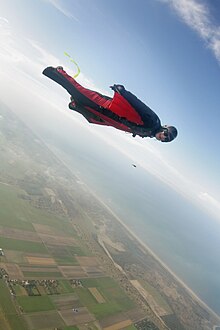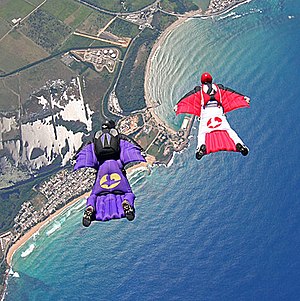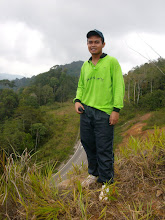WSBASE
Since 2003[6] many BASE jumpers have started using wingsuits, giving birth to WiSBASE, regarded by some as the future of BASE jumping and the best course of development of wingsuit flying. One technique, risky and spectacular, is proximity flying, which is flying close to the faces and ridges of mountains.
The longest verified WiSBASE jump is 5.8 km (3.6 mi) by Dean Potter[7] on August, 2009. Potter jumped from Eiger and had spent 2 minutes and 50 seconds in flight, covering 7,900 ft (2.4 km) of altitude.
Jet powered wingsuits
While still very experimental, powered wingsuits, often using small jet engines strapped to the feet[8] or a wingpack set-up, allow for even greater horizontal travel and even ascent. On 25 October 2005 in Lahti in Finland, Visa Parviainen jumped from a hot air balloon in a wingsuit with two small turbojet jet engines attached to his feet. The turbojets provided approximately 16 kgf (160 N, 35 lbf) of thrust each and ran on kerosene (JET A-1) fuel. Parviainen apparently achieved approximately 30 seconds of horizontal flight with no noticeable loss of altitude.[8] Christian Stadler (Birdman Chief Instructor) from Germany organized the first international wingsuit competition with prize money SkyJester's Wings over Marl in 2005. His world wide first archievement the VegaV3 wingsuit system uses an electronic adjustable hydrogen peroxide rocket[9] This rocket provided 100 kgf of thrust, it produces no flames or poisonous fumes. His first successful powered wingsuit jump was in 2007 with more than 160 mph horizontal speed.[10]
Training
Flying a wingsuit adds considerable complexity to a skydive. The United States Parachute Association (USPA) requires in the Skydivers Information Manual that any jumper flying a wingsuit for the first time have a minimum of 200 freefall skydives, made within the past 18 months, and receive one-on-one instruction from an experienced wing suit jumper, or 500 jumps experience to go without an instructor.[11] Requirements in other nations are similar. Wingsuit manufacturers offer training courses and certify instructors.
Records
The greatest verified horizontal distance flown in a wingsuit is 20.45 km (12.7 mi) by Alvaro Bulto, Santi Corella and Toni Lopez.[12] The three Spaniards crossed the Strait of Gibraltar on June 23, 2005, after jumping from an aircraft at an altitude of 35,000 ft (10.67 km). On July 24, 2008, Australian couple Heather Swan and Glenn Singleman jumped from 37,000 ft (11.27 km) over central Australia setting a world record for highest wingsuit jump.[13][14] At the time of writing, the Fédération Aéronautique Internationale has not established judging criteria for official world record wingsuit formations. However, several national organizations have established record categories and have established criteria for judging whether or not a wingsuit formation is complete. The largest wingsuit formation officially recognized as meeting the criteria for a national record consisted of 68 jumpers in an arrowhead formation which set a US National Record at Lake Elsinore, California, on 12 November 2009.[15][16] The largest unofficial record was a B-2 formation involving 71 jumpers at Lake Elsinore, California, in November 2008.


